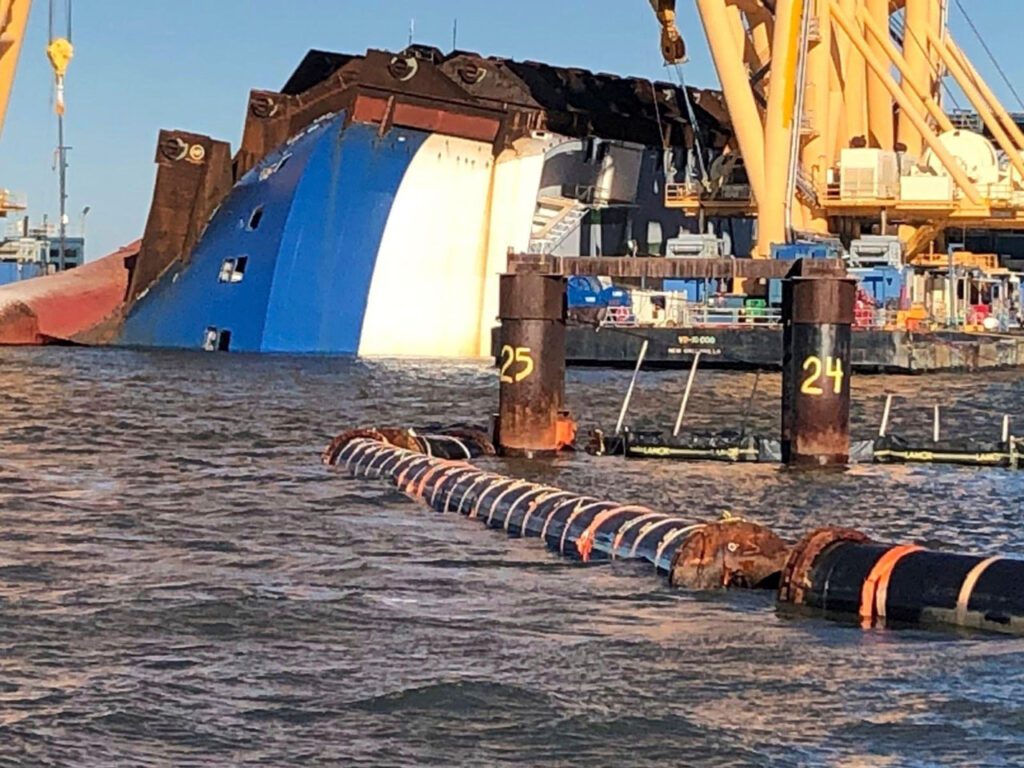Introduction
The reported USD one billion wreck removal of the capsized car carrier ‘GOLDEN RAY’ from the US east coast port of Brunswick, Georgia, has recently been completed. The underlying causes of the capsize, as established by a US National Transport Safety Bureau (NTSB) enquiry, were inadequate stability due to the Chief Officer’s human error failure in calculating the stability and accuracy oversight failure by the Master and Owners. This Risk Bulletin is focused on the very expensive lessons learned and their application to heighten stability awareness on board not only car carriers, but on board all ‘stability sensitive’ vessels (e.g. passenger ships, ferries, ro-pax vessels, livestock carriers and cellular sensitive container ships) operated by MM Members.
Background
Car carriers are effectively massive and specialist Ro-Ro vessels. Their huge and very high warehouse-like superstructures can, like the ‘GOLDEN RAY’s’, contain up to 12 or more vehicle decks. The result is that their ultra-high superstructures and high car deck cargo placement make car carriers extremely ‘stability sensitive’ (i.e. highly susceptible to stability loss). As such, there is little or no margin for error and the continuous maintenance of adequate stability must always be at the forefront of their Master’s and Chief Officer’s minds.
Regrettably, casualty evidence indicates that adequate stability awareness and pro-active precautions on board car carriers and similarly ‘stability sensitive’ vessels are frequently not what they should be. Examples include the car carrier ‘HOEGH OSAKA’s’ massive starboard list and intentional grounding to prevent a capsize. This occurred in January 2015, while outbound from Southampton, UK. The underlying cause was established by the UK’s Marine Accident Investigation Board (MAIB) to be inadequate stability.
One of the MAIB’s disturbing findings was that:
“…the practice of not calculating a departure stability condition on completion of cargo operations and before a ship sails extends…to the PCC/PCTC [Pure Car/Truck Carrier] sector in general”.
Ship Stability, Regulatory Requirements and Compliance
Members are referred to MM Risk Bulletin No. 30 on Stability Vigilance. This RB explains the term GM (Metacentric Height) as a measure of positive stability and GZ (Righting Lever) as a counter rotating force that brings a ship back from a listed position to an upright position. RB 30 also explains the fundamentals of ship stability and illustrates the conditions of Stable Equilibrium, Neutral Equilibrium and Unstable Equilibrium.
Additionally, RB 30 refers to flag state approved stability booklet content requirements, as obligated by the International Load Line Convention (LLC) and SOLAS and detailed in the International Code on Intact Stability (IS Code) 2008. The IS Code applies to all vessels in international trade which are regulated by the LLC and SOLAS and are over 24 m. in length. The IS Code may also apply to vessels in domestic trade under the terms of national law e.g. Indonesian NCVS, Chapter 6, Loadlines.
The IS Code also provides for the use of:
- A loading computer or instrument as a “…supplement to the approved stability booklet … to facilitate the stability calculations…”, as supported by;
- “A simple and straightforward instruction manual written … in a language common to all officers…”.
Further, RB 30 explains that the Master and Deck Officer minimum stability training requirements for the issue of Certificates of Competency are contained within the SCTW Convention at Tables A-II/1 and A-II/2. These requirements include crew training and assessment on the calculation of ship stability by reference to ship stability booklet data. However, they do not include the verification checks required to avoid errors and the optimum use of supplementary ship specific stability computers or instruments which are now recommended to be fitted on board a number of vessel types.
As to the Master’s stability assessment obligations, it is important to note the recent amendment to SOLAS Chap II – 1/20 which, as of 1 January 2020, extended the already existing stability obligations of the masters of passenger ships to all cargo vessels as follows:
“On completion of loading… and prior to departure, the master shall determine the ship’s trim and stability and also ascertain and record that the ship is … in compliance with stability criteria in relevant regulations.”
SOLAS also stipulates that the master’s determination of stability shall always be made by calculation or by loading the vessel in accordance with one of the pre-calculated loading conditions in the vessel’s approved stability booklet.
NOTE: The above noted amendment to SOLAS was not in force at the time of the GR’s capsize on 19 September 2019.
‘GOLDEN RAY’ capsize: the essential facts
The “GOLDEN RAY’ (GT 71,118 and capacity 7,400 cars) was built at a Hyundai shipyard in 2017, only two years before her constructive total loss due to capsize in Sept of 2019. She was registered in the Marshall Islands and owned by Hyundai Glovis, which operates a fleet of 51 vessels. Her Master and officers were all Korean nationals. They all held appropriate COCs and had prior car carrier experience. Long term charterers were car manufacturers, Hyundai.
The ‘GOLDEN RAY’ (GR) was engaged in in the coastal movement of Hyundai cars and vehicles between various US east coast ports. The cargo planning and advice on total cargo weights was provided by the charterer’s contractor but they had no responsibility for calculating or checking the stability of the vessel.
Stability calculation was therefore left entirely to the GR’s Chief Officer (C/O). He was familiar with the vessel and the trade as he had had served on board for six months at the material time. However, there was no evidence that there had been any stability calculation audit or oversight by the Master or any other party during the C/O’s time on board and the numerous voyages accomplished within that period.
The GR was provided with all requisite certification, inclusive of a flag state approved stability data booklet. She was also fitted with a sophisticated stability calculation computer, LOADCOM, which had the ability to calculate the GR’s stability using three different modes.
- Manual entry of all position and weight data for cargo, fuel, fresh water and ballast on board and calculation of the GM by reference to the data contained in the vessel’s approved stability booklet as loaded to the computer.
- Automated entry of all of the above position and weight data through connection of the LOADCOM stability computer with the vessel’s Integrated Monitoring, Alarm and Control System (IMACS) and calculation of the GM as noted above.
- A GM check process, independent of Modes 2 and 3, which calculated the GM by automatically pumping ballast to heel the vessel 1º to each side and then measuring the weight of the ballast transferred.
NOTE: Mode 3 was based on the physical ‘inclining experiment’ methodology used to establish a vessel’s GM. As such, it negated the impact of any Mode 1 cargo/fuel/ballast weight entry errors made by the stability computer operator.
Cargo operations at the Port of Brunswick consisted of unloading 319 m.tons of vehicles and loading 692 m.tons of vehicles. This resulted in a relatively small net cargo weight increase of 373 m.tons such that, on completion of operations, there were 4,161 vehicles on board with a total weight of 8780.3 m.tons.
The C/O was then required to calculate the GM, so he could check this figure against the minimum requirements of the approved stability booklet and the IS Code. He stated that he had used the LOADCOM Mode 1 manual entry method to calculate the GM but had not used Mode 3 as an independent check. Oddly, the NTSB report contains no information as why the C/O did not use Mode 3 to verify his Mode 1 GM calculation.
The C/O stated that the LOADCOM Mode 1 calculated GM was 2.45 metres and that the LOADCOM system confirmed this was “OK”, i.e. not less than the requisite minimum. The C/O then reported this to the Master who, in turn, was required by the vessel’s SMS procedures “… to be satisfied that the ship has sufficient stability at all times.”
NOTE: It appears the Master accepted the C/O’s GM figure and his advice that it was within stability booklet tolerance but without the Master actually checking that this was in fact the case.
The GR departed the berth at 00:53 hrs on 8 Sept 2019 under the conduct of an experienced local pilot and then commenced navigation of the Port Brunswick channel out to the pilot disembarkation station and the open sea. The Master subsequently instructed the crew to open the electrically operated pilot access door (situated in the port side of the GR’s hull at car deck 5 level, low down in the hull) and rig the pilot ladder.
As later confirmed from IMACS data, the Master failed to ensure that the two main watertight compartment doors located inside the car deck of the hull were closed. By reference to the GR’s SMS procedures, these doors should have been ordered and confirmed as closed prior to departure from the berth.
The GR’s IMACS and VDR data showed that the initial part of the pilotage passage proceeded without incident and the GR’s speed was gradually increased to manoeuvring full ahead of about 12-13 knots. Two 38º degree course alterations to port were made at this speed using up to 20º of port helm. No significant listing of the GR – which would normally indicate an inadequate GM – was experienced during these two turns.
Later, at 01:36:31 hrs and with the GR’s speed at 13.3 knots, the pilot commenced a 68º turn to starboard by first ordering 10º of starboard helm followed by an increase to 20º. As stated by the pilot, the GR then appears to have ‘taken off’ to starboard and had become ‘directionally unstable’. He then quickly ordered helm amidships and then port helm to counteract the rapid swing to starboard and a resulting large and rapidly increasing port list.
The pilot’s and master’s emergency actions were to no avail. The GR then grounded, just outside the channel, with a list of 60º to port. All power was lost, and the emergency generator failed to run for more than a few minutes. At the same time, sea water began to flood into the open port pilot access door and then spread quickly throughout the car decks through the open watertight doors.
Crew Rescue
Emergency response from specialist shore teams was both rapid and effective with 19 of the GR’s 23-person crew being rescued by 06:45 hrs. Crew injuries were relatively minor.
At about 09:00 hrs, the GR sank further into the muddy channel side bottom and then rolled further over on her port side to 90º.
The balance of 4 unrecovered crew were all engineers, trapped in the engine room by the sea water that flooded into the hull through the open pilot access door and open car deck watertight doors. They were all recovered – unharmed – by emergency responders on the next day, 9 Sept.
NTSB and USCG Stability Findings
The NTSB’s investigation was initially hindered by the fact that the CR’s LOADCOM unit was seriously damage by sea water ingress and no data could be retrieved from it. This problem was overcome through detailed stability calculations made by the USCG’s Marine Safety Centre (MSC) which were based on the GR’s stability booklet data.
The MSC’s findings were that the C/O’s stability calculation of a GM of 2.45 M. was evidently incorrect as their own calculation, using the declared weights on board, had produced a GM figure of 1.76 M.
MSC also ascertained, by reference to the GR’s stability booklet example load conditions and cross curves of stability, that the minimum stability for the GR’s loaded condition should have been not less than a GM of 2.54 meters.
Further, the MSC determined, by reference to both the requirements of the IS Code and the GR’s stability booklet, that the GR’s righting lever (GZ) and the area under the GZ curves for angles of heel – particularly between 30º and 40º – failed to meet minimum requirements of the IS Code’s ‘severe wind and rolling’ criteria.
The MSC concluded that: “…the vessel, as loaded, had an extremely low righting energy, which prevented it from withstanding further adverse static or dynamic adverse heeling effects and enabled the vessel to capsize due to the centrifugal force experienced by the vessel throughout the starboard turn.”
Additionally, the MSC ascertained that the GR’s stability during the previous two voyages had also been inadequate to a degree that a capsize could also have occurred during those voyages.
NTSB Analysis and Probable Causes
The NTSB/MSC stability evidence is that the C/O made a serious error when manually inputting the cargo/fuel/ballast weights into the LOADCOM stability computer. But precisely what was his error?
The NTSB considered it likely that the C/O had entered the water ballast quantities into the LOADCOM incorrectly in that he had forgotten he had discharged 1492 m.tons of ballast to lighten the CR to meet a maximum draft requirement at the previous port. As a consequence, the CR was dangerously under ballasted.
NOTE: The C/O was not available to clarify the source of the ballast entry error to the NTSB as had already been repatriated to Korea. He then declined to provide any further information to the NTSB.
The NTSB also concluded that the C/O’s error had been compounded by the fact that the GR’s SMS procedures were not specific as to precisely how the master was required to verify (e.g. by way of an independent check) the accuracy of the C/O’s advice that the vessel’s stability was both correct and sufficient.
NTSB Recommendations to Prevent Recurrence
The NTSB made formal recommendations to the GR’s owners. They are restated as below, together with commentary NOTES to assist MM Members.
- Revise your vessel’s SMS to provide procedures for verifying the accuracy of stability calculations.
NOTE: Verification of the C/O’s LOADCOM Mode 1 manual stability calculation could have been accomplished by use of both the Mode 2 and Mode 3 functions. This was not done and appears to have been a recurrent failing.
- Implement SMS audit procedures to ensure your vessel complies with both ship stability booklet criteria and IS Code stability requirements before she departs from the berth.
NOTE: The Master did not conduct an independent check of the C/O’s advice that the vessel’s stability was sufficient. This appears to have been a recurrent failing. - Revise your vessel’s SMS audit process to verify crew adherence to the Arrival/Departure Checklists regarding the closure of watertight doors.
NOTE: The Master did not ensure that watertight doors were closed and logged as such prior to departure. This appears to have been a recurrent failing.
Conclusion and Takeaway
The human error failure of the GR’s chief officer and master’s evident complacency in ensuring the accuracy and adequacy of the vessel’s stability resulted in a disastrous capsize with hull insurance claims of USD 62 million, cargo claims of USD 162.5 million and wreck removal costs exceeding USD one billion. This could all have been avoided by ensuring full compliance with SOLAS and LLC stability regulations together with IS Code and ISM Code adherence obligations.
Members are encouraged to share this Risk Bulletin with their ship managers, DPAs and Masters. Members are also urged to review the approved stability data, the instructions for the use of any stability computers and all associated SMS procedures (which should be focused on recognising and negating the risk of human error) which are provided on board their ships. Any necessary updating and amendment should then be made, recorded and implemented as soon as possible.
Finally, Members are respectfully reminded that an entered vessel which departs from her berth with inadequate stability will likely not be in compliance with either the applicable IMO Conventions and Codes or the NCVS Regulations which apply to her operation. Nor could the vessel be considered to be seaworthy. Members should therefore consider the negative impacts these issues might have on both their H&M and P&I insurance cover.


